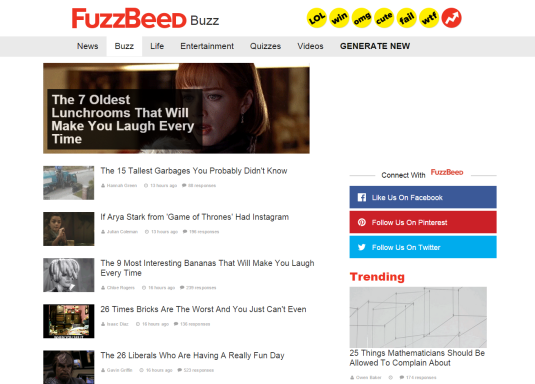BuzzFeed, FuzzBeed and the Unbearable Blandness of Focusing on Shareability
 On February 3, 2015, the viral content megalith Buzzfeed registered 14,450,212 unique visitors, according to Quantcast, a company that measures real-time web traffic. On a monthly basis, Buzzfeed outranks eBay, Pinterest, Wikipedia and Weather.com in terms of U.S. visitors. It outranks every major news site, every entertainment outlet and every search engine except Google.
On February 3, 2015, the viral content megalith Buzzfeed registered 14,450,212 unique visitors, according to Quantcast, a company that measures real-time web traffic. On a monthly basis, Buzzfeed outranks eBay, Pinterest, Wikipedia and Weather.com in terms of U.S. visitors. It outranks every major news site, every entertainment outlet and every search engine except Google.
That’s astounding, especially when you consider that most of the content on Buzzfeed is… well, let’s just say it’s not known for its gravitas or its many Pulitzers. If you’re not familiar with Buzzfeed, then a) you’re probably way more productive than I am, and b) you should go check it out for a few minutes. Or possibly a few hours. I’ll wait.
Welcome back! While not all the content on BuzzFeed is frivolous (the site does have a News section with a slightly more subdued layout), it’s mostly known for its listicles, quizzes, videos and gif showcases. It’s large-scale viral content, often user-created, often featuring Jennifer Lawrence. It offers users easily shareable entertainment, appealing to interest in popular culture, nostalgia, lifestyles and Internet shenanigans.
In short, it’s clickbait. Or rather it’s the Queen Mother of clickbait sites. It relies heavily on teaser titles, withholding information to promote site hits and a rhetorical style that can border on pandering. “You won’t believe what happens when X” and “Watch what this guy did when Y” and “10 Things You didn’t know about X” are common title structures.
Predictably, this kind of ubiquitous, highly stylized content leads to copycats, spoofs and parodies. My favorite of these is the automatically generated FuzzBeed, which populates templates with random Buzzfeed-esque phrases and images. It looks very similar to Buzzfeed, but it reads like a fever dream.
Some of the delightfully surreal topics FuzzBeed has produced are “24 Bicycles That Scream World Domination” and “25 Owls For Gymnasts That Really Shouldn’t Exist.” However, occasionally the titles are indistinguishable from real Buzzfeed posts, such as “If Arya Stark from ‘Game of Thrones’ Had Instagram” and “The 12 Things Mothers Know To Be True.”
You can also generate your own article (I got “The 20 Richest Cactuses Of Last Summer”) or your own Quiz (“Which Avatar: The Last Airbender Characters Are You?”). The site updates about every half hour, so there’s always fresh insanity to enjoy.
Once you click on an article, you’re greeted with more randomized text, but it’s formatted to read like BuzzFeed’s recognizable tone. It doesn’t make sense, but if you’ve seen enough Buzzfeed/clickbait lists, it ALMOST makes sense, at least enough to recognizably sound like content we’re all familiar with. And that is troubling to me.
Last summer, I read an article that really resonated with me called “The Internet has a content diversity problem” by Matt Saccaro of The Daily Dot. In it, he discusses what consumers and creators of Internet content know to be true, that “[d]igital publications have become so obsessed with creating content “Worth Sharing” they’ve forgotten about writing stories that are worth reading.” Amen.
I enjoy a good list of popular 90’s toys or gender-swapped Disney characters as much as the next red-blooded Internetter, but when you look at the sheer quantity of this type of content across all kinds of organizations, you start to wonder, just how lazy are we as writers? Or rather, is it even possible anymore to create popular viral content without succumbing to the “BuzzFeedification” temptation?
As content marketers, we KNOW theoretically that good content has a unique voice. It offers something new and different. But when we’re faced with website traffic goals and advertising concerns, it’s so tempting to fall into the trap of “This works for other sites… Let’s plug in a slightly different set of variables and surely it’ll work for us! I mean look at BuzzFeed’s numbers!” And perhaps you will occasionally get higher numbers if you employ a bit of formulaic pandering.
But do you want to create something that’s personal, relevant and memorable? Then resist the urge to jump on the bland gif-response bandwagon. Refrain from posting yet another insipid “10 Things Content Marketers in Their Early 30s with Pets Know to Be True” article unless you truly have 10 insightful items to share. And don’t mention bacon unless you’re employed by a meat curing facility.
I’m not saying never utilize the formats popularized by large viral content sites, but unless you want to be known for content that could easily have been produced by a random generator, make sure you’re not relying on these formats as a crutch. Your clients, your supervisors, your integrity and your 24 gymnast-specific owls will thank you for it.
Enjoyed this post? Read more from Sally.
Sally Boman – Writer/Editor



